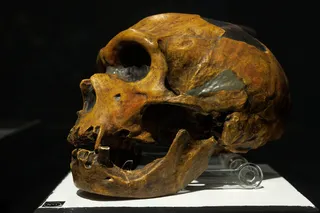An interesting report in (believe it or not) Medical Hypotheses – Alternating gender incongruity: A new neuropsychiatric syndrome providing insight into the dynamic plasticity of brain-sex.

Bigender individuals report alternating between male, female, and (sometimes) mixed gender states. Case and Ramachandran – that’s V.S. Ramachandran of phantom limb fame – write:
Under the transgender umbrella, a distinct subset of “Bigender” individuals report blending or alternating gender states. It came to our attention that many (perhaps most) bigender individuals experience involuntary alternation between male and female states, or between male, female, and additional androgynous or othergendered identities (“Multigender”)…
But almost no-one’s studied the bigender phenomenon –
A survey of the transgender community by the San Francisco Department of Public Health found that about 3% of genetic males and 8% of genetically female transgendered individuals identified as bigender. To our knowledge, however, no scientific literature has attempted to explain or even describe bigenderism; a search of PsychInfo and PubMed databases returned zero results… the study of this condition could prove illuminating to scientific understanding of gender, body representation, and the nature of self.
No scholarly paper would be complete without some elaborate new jargon, of course –
For the purposes of our research we are calling this condition “alternating gender incongruity” (AGI). We seek to establish AGI as a nosological entity based in an understanding of dynamic brain representations of gender and sex.
So they designed a survey (details in the paper) and sent it to members of a bigender internet forum. The forum had 600 members, although many were lurkers; they got a total of 39 replies. So it’s a highly self-selected sample, then, but that’s inevitable I think. Here’s what they had to say –
Of the 32 alternating bigender respondents included [some were excluded for diagnoses of DID etc], 11 were anatomically female (identified as female at birth)… One respondent identified as intersex, but only for reasons of androgynous facial appearance…
10/32 respondents agreed that their gender switches were “predictable.” The period of gender switches was highly variable, ranging from multiple times per day to several times per year. A majority (23/32) of respondents, however, reported that their gender switched at least weekly [with 14 saying it switched at least once per day].
What are the switches like? Some respondents are quoted –
“I still have the same values and beliefs, but a change in gender is really a change in the filter through which I interact with the world and through which it interacts with me.”
“My voice usually ends up being higher than other times, I’ll be more emotional, my views on things like politics tend not to change, but how I react to certain things does. Like if I’m in male mode and I see someone crying I’ll think more along the lines of, ‘Man up…’ while if I’m in girl mode I’ll think more along the lines of ‘Oh sweety!’”
This being Ramachandran, the paper also touches on left handedness, brain hemispheres, phantom genitals and more, but it’s fair to say that all this is pretty speculative –
In myth, art, and tradition throughout the world the left side of the body (and hand) – and therefore the right hemisphere – is regarded as more “feminine” – intuitive and artistic. One wonders therefore whether gender alternation may reflect alternation of control of the two hemispheres. Such alternation is seen to a limited extent even in normal individuals but may be exaggerated (and more directly involve the gender aspect) in AGI…
Personally, what I find most interesting about this is the question of what would have happened to ‘bigender’ people before the term ‘bigender’ came along; it seems to be newer, and certainly less widely used, than ‘transgender’/’transsexual’.
Would they have been identified as transgender? Maybe… but maybe not. Would they have had any label at all?
Case, L., and Ramachandran, V. (2012). Alternating gender incongruity: A new neuropsychiatric syndrome providing insight into the dynamic plasticity of brain-sex Medical Hypotheses, 78(5), 626-631 DOI: 10.1016/j.mehy.2012.01.041













